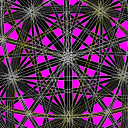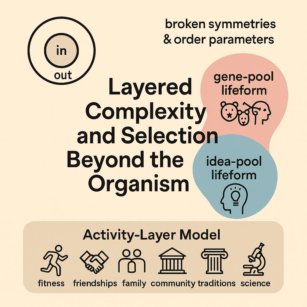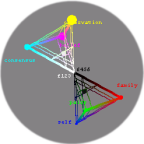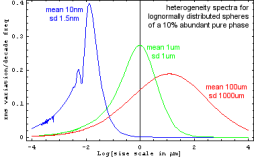









/A. Orcim Namuh (1997)


























 .
.
My education mandate is served by teaching courses, and by developing strategies for introducing newcomers to information physics, electron imaging, and relativistic acceleration, which are being implemented in various ways. They are attracting expressions of interest from educators, authors, and researchers far and wide.
Among research goals for our group, material problems include defects in and on VLSI silicon and mica, lateral displacement map studies of friction forces on the submicron scale, and the 2D/3D core/rim structure of micron-sized graphite onions formed in the atmosphere of red giant stars and delivered to earth in meteorites. Instrument activities involve new techniques of scanning displacement microscopy and tip shape monitoring, as well as instrument response analysis in general using scanned probe and transmission electron microscopes with sub-2A resolution. These scopes are moving into a CME building designed & built for such instruments in Fall 1996. Related math challenges involve Bayesian strategies for measuring and locating periodicities in, and imagining periodicities just outside, of experimentally imaged regions of solid specimens.
| Area | Folks | Stuff | Tools | Math |
|---|---|---|---|---|
| Bulk Solids | Lucio Mulestagno, Aaron Gray & Kurt Pollack | VLSI silicon defect-management, & molybdenum disulfide | Confocal IR scattering & analytical electron microscopy | Solid state nucleation/growth, scattering theory |
| Grains & Films | David Dawkins, Wentao Qin, Kay Brewer & Haresh Siriwardane | Red giant graphite onion cores & CVD of iron nitrides | HREM imaging & phase identification | Modeling 2D crystal images, and electron diffraction/power spectrum analysis |
| Nuclear Tracks | Lu Fei, Jeff Tentschert & Gniewko Lubecki | Nuclear track pits in surfaces | SPM tip-shape monitoring | Pit profile inversion, touch-map models |
| Friction, Adhesion, Hardness, & Capacitance | Chang Shen & Richard Anderson | Nano-scale friction forces, Conductive polymers, and Diamond-like carbon | Lateral displacement microscopy in STM & A/LFM | Image-pair vector displacement maps, Stereo-pair analysis |
| Surface Topography | Lu Fei & Lucio Mulestagno | Steps on VLSI silicon, mica height calibration, computer imaginations, & platinum anneals | Scanned probe roughness spectroscopy, the line of hemispheres, & time-domain noise removal | Bayesian prediction & Bayesian background subtraction |
| Area | Folks | Stuff | Tools | Math |
|---|---|---|---|---|
| The Traveler Kinematic | Srinivasa Varadharajan | The land-speed record for particles, The collider bargain | Proper velocity & frame-invariant acceleration, Visual Basic | Non-coordinate time/velocity pairs in special relativity |
| Pre-Transform Relativity | Xuewei Hu | Travel time to Andromeda, Speed limits of the fast & famous, Unsolved Problems in Constant Acceleration | Roddenberries & the Galilean chase plane | Three self-consistent kinematics in (1+1)D special relativity |
| Getting Small | See the detective quilt above | Zeptoliter units, Long fat electrons, Web-based HREM (electron phase contrast) image focusing | Uncertainty principle, Hypertext markup language | Strong phase object approximation |
| Gambling Theory & Temperature | Ed Jaynes | Life's power stream, two absolute zeros, temperature in eV/bit, heat capacity in bits per 2-fold increase in energy | Statistical inference | Lagrange multipliers |
| Codes & Excitations | Jayne Stake | Information engines, noble passions, personality types & the evolution of grace | Intuition | Physical information theory |
| Area | Folks | Stuff | Tools | Codes |
|---|---|---|---|---|
| St. Louis Consortium for Microstructural Studies | Pat Gibbons, Ken Kelton, Dan Schwartz, Jimmy Liu, Tom Bernatowicz, Dick Ornberg, Joe Holzer, Pat Kinlen, Bruce Frushour, Bill Haynes, Lucio Mulestagno, Rod Ruoff, Jan Ryerse, Lu Fei, Chang Shen, Haresh Siriwardane, Don Parker, Frank May, Rick Dorshow, John Heuser | A center without walls | Electrons, photons & phonons | Real & complex numbers |
| UM-StL Center for Molecular Electronics | Tom Jones, Bernard Feldman, Bill Welsh & Jim O'Brien et al. | Industry collaborations, a research building with vibration-sheltered space, & a surface science talk series | Atom-resolution microscopies, molecular modeling, materials synthesis, education | Silicon Graphics & Sun |
| Missouri Center for Excellence in Silicon Science & Technology | Marsha Melitz | Work toward state-funded catalysis of resources to keep and attract electronics industry employers | Discussions & proposals | Word processing |
| Two-Armed Physicists | Haresh Siriwardane | Fire-fighting for industry, Contacts & jobs for students | Scanned probe & electron microscopes | Semper & NIH image |
| Bachelor's in Physics with Sci/Tech Emphasis | Lucio Mulestagno | Job-ready graduates | Industry collaborations | Code of ethics for analytical support |
| Course-Linked Annual-Celebration of Important Ideas | Charlie Burkhardt | An electronic one-room school-house, delivering science through culture | Onion-peel learning, Rydberg atoms, & candle dances | E-mail & the web |